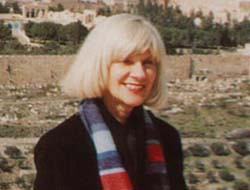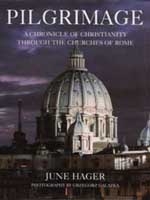Welcome
Floorplan
The
Square
Documents
Images
|
|
June Hager lives in Rome. She has written about Italy, art history and interreligous dialogue for Time Magazine and a number of US-based Catholic periodicals. Currently she acts as Managing Editor of the US-based monthly, Inside the Vatican, where she reports on Church art history and Vatican politics. Her monthly feature entitled 'Churches of Rome' served as the inspiration for the book, 'Pilgrimage: A Chronicle of Christianity Through the Churches of Rome' |
|
|
Pilgrimage: A Chronicle of Christianity Through the Churches of Rome by © June Hager, Cassells, 2001 Read the Chapter S. PIETRO IN VATICANO at stpetersbasilica.org
|
|
The Cardinal's Forward Rome is famous as the 'city of a thousand churches'. The author of the present volume has chosen that unique characteristic to illustrate 2,000 years of Christian history in Rome - from the ancient catacombs to the most recent churches raised, sometimes haphazardly, in the sprawling suburbs. She has done this for the occasion of the Great Jubilee for the Year 2000, in response to Pope John Paul II's invitation, in his apostolic letter Tertio Millenio Adveniente, to give glory to God by recalling the beauty the Church has brought to the world during its two-millennial history. Before the pilgrim's eyes, the author parades twenty centuries of history in the Eternal City. Descriptions of churches from many different eras evoke the 'historical-religious memory' of the world capital, where, after the fall of the Roman Empire, life centered around the Roman Church and, to a large extent, took place in Roman churches. These sacred edifices were often the centre of family and social life for the Roman people. Their placement largely determined the city's physical aspect. The writer examines their historical origins, evolving religious and civic functions, and the roles the churches played in the daily lives of Roman citizens. The result is a broad panorama - enriched by events, personages, and some surprising new findings - of the influence Rome's churches had on everyday life. In the course of this long and lively chronicle, the spiritual importance of Rome's churches becomes very clear. Centres of assembly and prayer, of ritual and liturgy and popular piety, the churches of Rome disseminated faith and practice throughout the universal Church. I feel certain that upon opening the pages of this book the reader will discover a mine of historical information, fascinating stories and practical suggestions. In the course of an entertaining and informative itinerary, the pilgrim will come to understand how Rome's places of worship gave birth to that Christian civilization which now characterizes not only Rome, but much of the Western world as well. Francesco Archbishop
Marchisano Editors note: Since
this writing, Archbishop Marchisano has been elevated to Cardinal
and appointed Archpriest of St. Peter's Basilica. Francesco Cardinal
Marchisano
|



